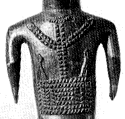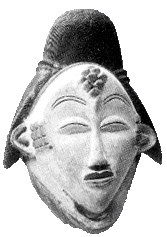![]()
 As in the essentially anti-Romantic
arts of medieval Europe, traditional African body decoration and sculpture elevate
the human above both the merely natural (in reality) and the merely realistic
(in aesthetics). Scarification, tatooing, and body piercing therefore parallel
the characteristic African aesthetic emphasis upon composure,
balance, and calm in an important way, for both represent ways of separating
the human from the less-than-human -- the animal, the natural. As Susan Mullin
Vogel explains, "Scarification and other forms of body decoration were traditionally
considered marks of civilization. They distinguished the civilized, socialized
human body from the body in its natural state and from animals. The Chokwe say
that teeth not filed to points are like the teeth of animals" [Aesthetics
of African Art: The Carlo Monzino Collection, N.Y.: Center for African Art,
1986, 25; images from Willet, 189, 221].
As in the essentially anti-Romantic
arts of medieval Europe, traditional African body decoration and sculpture elevate
the human above both the merely natural (in reality) and the merely realistic
(in aesthetics). Scarification, tatooing, and body piercing therefore parallel
the characteristic African aesthetic emphasis upon composure,
balance, and calm in an important way, for both represent ways of separating
the human from the less-than-human -- the animal, the natural. As Susan Mullin
Vogel explains, "Scarification and other forms of body decoration were traditionally
considered marks of civilization. They distinguished the civilized, socialized
human body from the body in its natural state and from animals. The Chokwe say
that teeth not filed to points are like the teeth of animals" [Aesthetics
of African Art: The Carlo Monzino Collection, N.Y.: Center for African Art,
1986, 25; images from Willet, 189, 221].
 Such body modification, she explains, largely occurs "during adolescence, often at rituals that celebrate the accession to adulthood," and it "marks progressive stages of social integration and standing, such as parenthood, and it marks one as a member of one's group" (25). Scarification thus functions as a multiple border marker -- separating the human from the animal, the individual at a particular life-stage from those at all others, and members of one tribal or ethnic group from outsiders.
Such body modification, she explains, largely occurs "during adolescence, often at rituals that celebrate the accession to adulthood," and it "marks progressive stages of social integration and standing, such as parenthood, and it marks one as a member of one's group" (25). Scarification thus functions as a multiple border marker -- separating the human from the animal, the individual at a particular life-stage from those at all others, and members of one tribal or ethnic group from outsiders.
Scarification serves as a sign of character as well, since it is "not only beautiful to look at and arousing to touch but it is also proof of stamina and courage, characteristics necessary to undergo the painful operation" (25) -- something apparent in Soyinka's description of his scarification in Aké.
If changing the physical body thus combines the aesthetic, philosophical, and social much as do other African aesthetic qualities, how does African body modification relate to scarification, tatooing, and body piercing in the West, and how do both relate to elective cosmetic surgery?